Real leather does not peel nor flake. The only exception is if a leather’s urethane finish has been damaged. In this case, you’ll notice the grain and texture remain intact, and it’s easily corrected. See here.
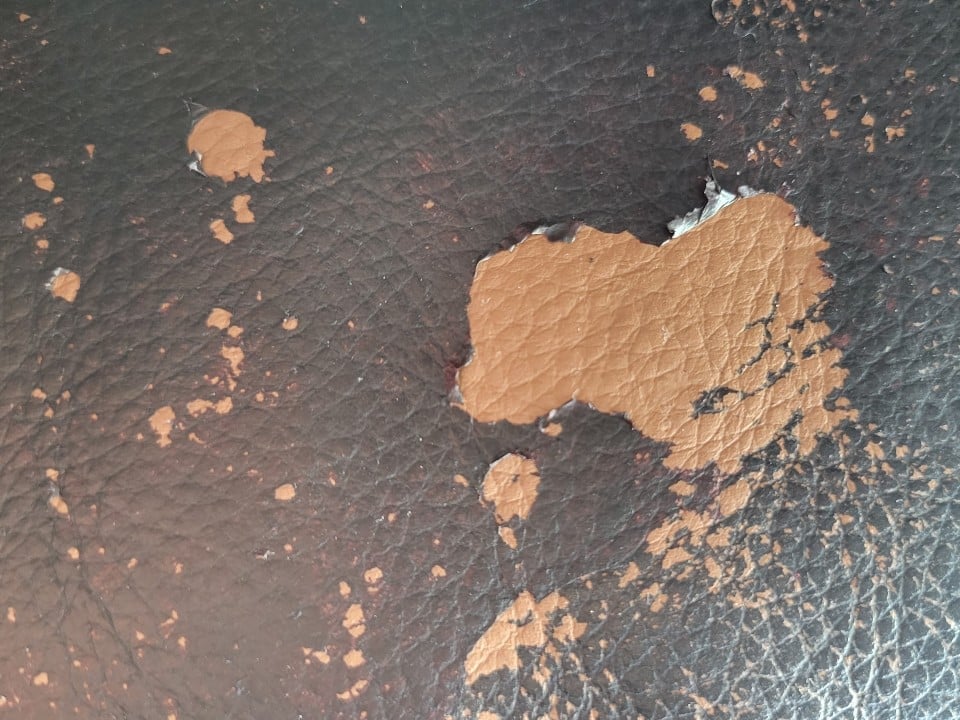
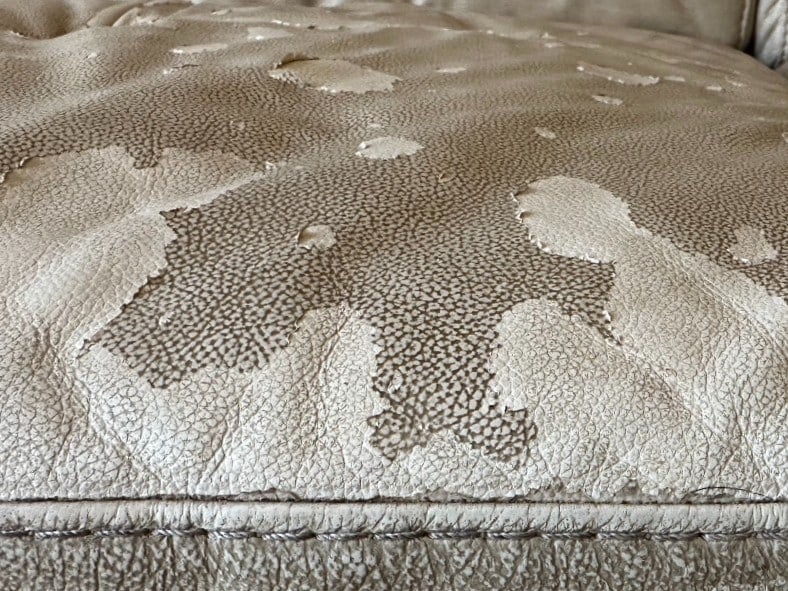
More often, peeling is a sign of fake leather whose polyurethane (PU) coating has begun to delaminate from the underlying fabric.
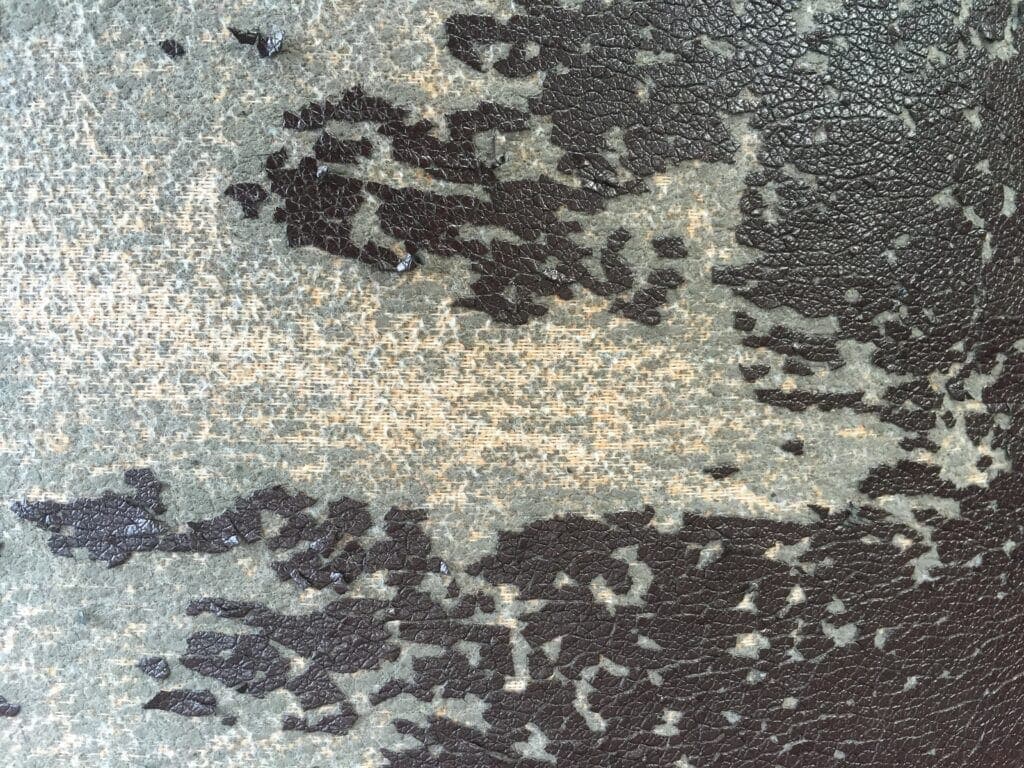
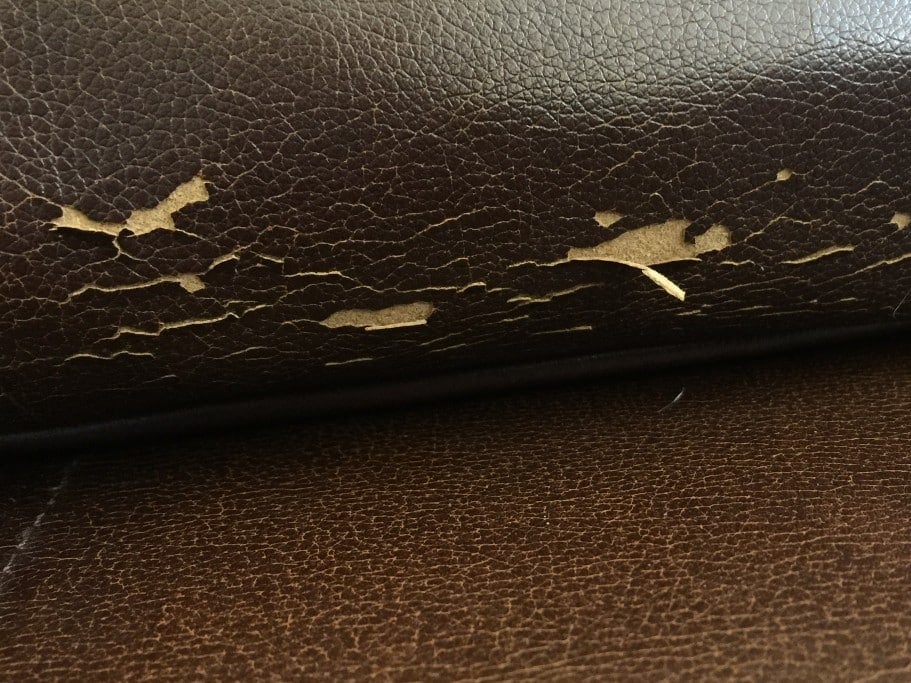
There’s nothing that can be done to prevent or protect it, and repairs seldom last.
Click here to jump ahead to the repair options.
What are bonded and faux leather?
Bonded leather (also called blended or reconstituted leather) is a composite material made of 10-20% ground scrap leather coated with a polyurethane ‘skin’. DuraBlend® and EnviroBlend® are US trademarked names for bonded leather.
Faux (the French word for ‘fake’) and vegan leather are rayon or polyester fabric coated with polyurethane ‘skin’. They are 100% synthetic. Ultraleather® is a trademarked brand of faux leather.
Polyurethane (PU) materials are the equivalent of cheap particle board and are not to be confused with better quality vinyl (PVC), which is widely used in boat, auto, and furniture upholstery.
Vinyl is very toxic to produce, however, which is why polyurethane-coated artificial leathers were developed in response.
Unfortunately, these polyurethane coatings often develop hairline cracks and delaminate in as little as 18 months — just as the warranty has expired. This is known as ‘hydrolysis-related failure’ by the industry and is specifically excluded from many warranty policies.
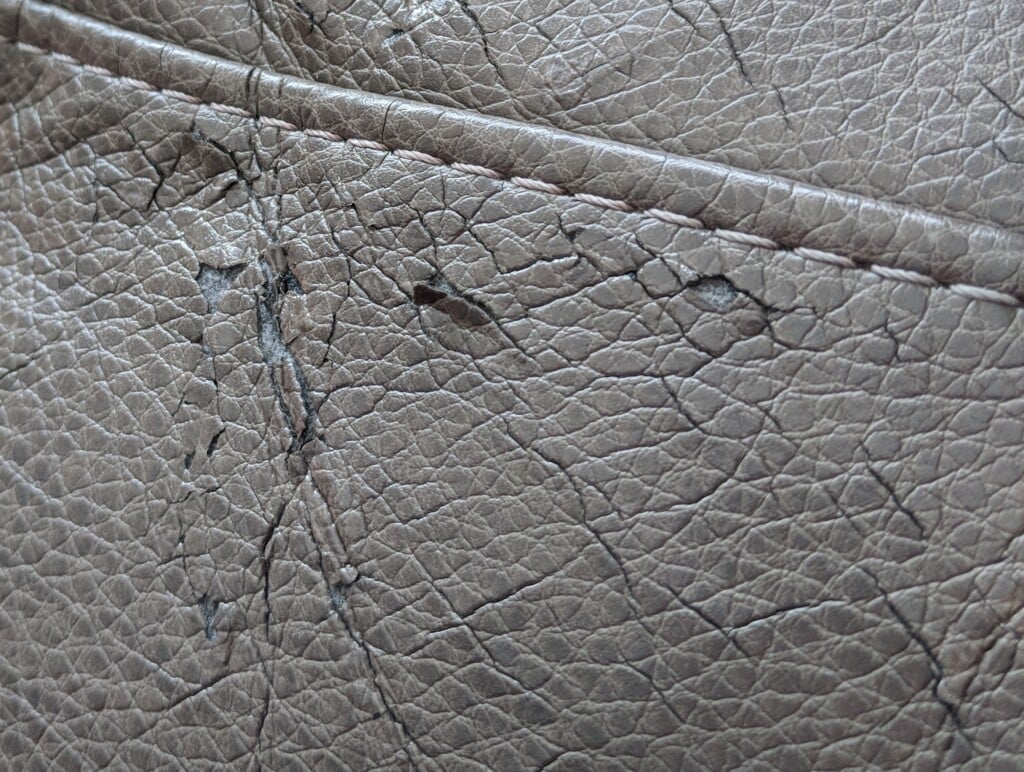
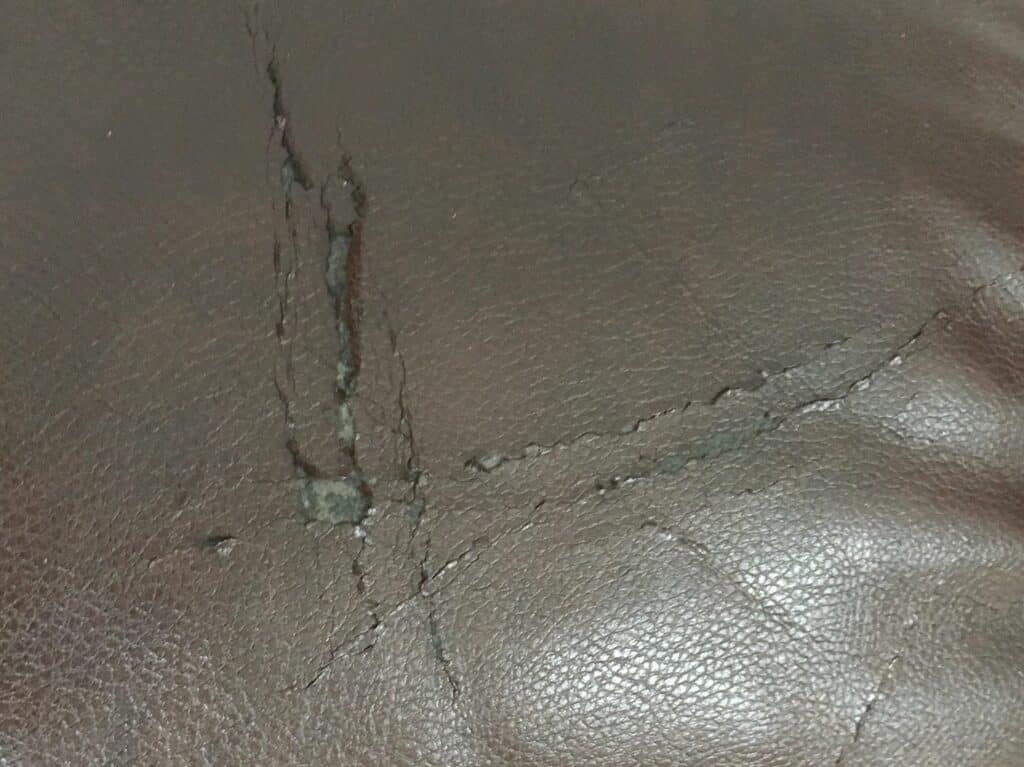
The industry uses ISO 1419 Tropical Test Method C (nicknamed the Jungle Test) to assess a material’s ‘hydrolysis resistance’, or rather, if and when a bonded or faux leather will crack, peel or delaminate in hot, humid conditions. The Association for Contract Textiles’ guideline recommends a minimum 5 week rating. “Note that there is no direct correlation of testing weeks to years of service in the field.” Even the best polyurethane resins for commercial use were never expected to last more than a few years.
What toxic pollution was spared by producing PU instead of PVC is neutered by its disposability and profusion in landfills.
Why are consumers misled about faux and bonded leather?
Most folks — consumers and salespeople alike — don’t know how to tell the difference between real and artificial leathers and often assume it’s real simply because ‘leather’ appears somewhere in the description. It wasn’t until 2017 that the term ‘leather’ came to be regulated in the United States.
Still, ignorance and affordability allow these inferior fake leathers to prevail.
Even at a wholesale price, top grain leather costs about $100 / yard. Full grain costs even more, and it takes many yards to upholster a piece of furniture:
- large club chair: 5-7 yards = $500-$700 leather cost
- 3-seat couch: 15-20 yards = $1,500-$2,000 leather cost
- 5 or 6-seat sectional: 30 yards = $3,000 leather cost
These 2023 figures don’t include other materials like the wood or metal frame, foam stuffing, the labor, let alone inflation. Do the math. If you paid $1,500-$2,000 for a new leather couch, it is likely fake.
There’s no product that can stop ‘leather’ from peeling.
The instability of bonded and faux leather means repair compounds and new coatings don’t adhere well. The video in option 2 below demonstrates how you’d repair it and the disappointing month-later result. We’re big fans of turning trash into treasure, but peeling bonded or faux leather is rarely worth the effort.
Ask yourself: do you want to spend time and money to improve its appearance, knowing such an improvement may be short-lived and likely a waste (option 1 and option 2)? Or would you rather invest a similar amount of time and money in a better-quality piece that will last years, even decades (option 3)?
Option 1: Stain the Fabric
Peel and scrape away as much of the unstable polyurethane ‘skin’ as possible, and stain the exposed fabric with one of our water-based paints.
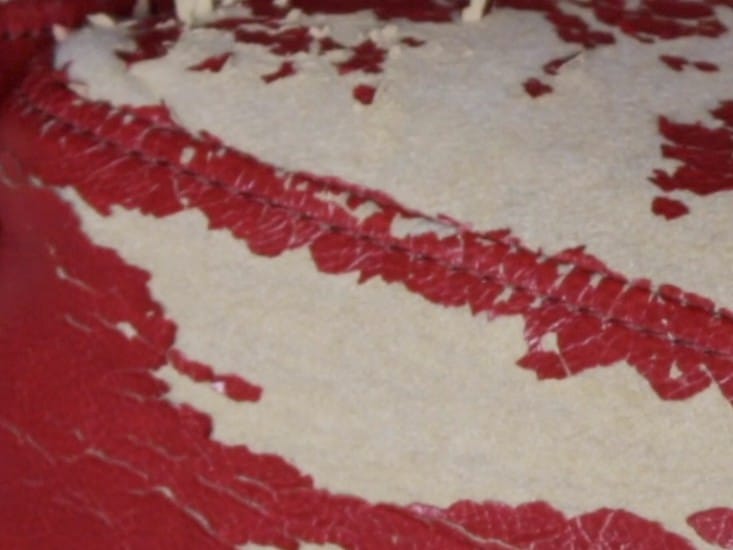
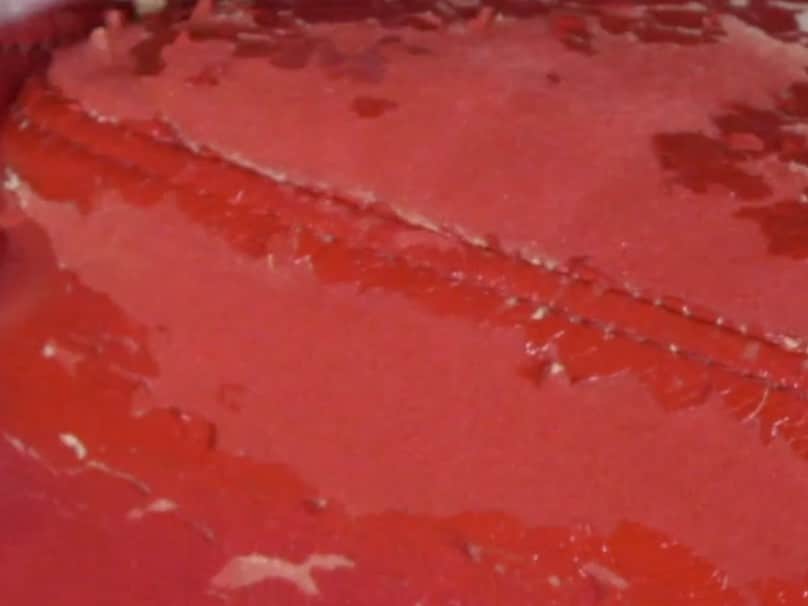
This improves appearance somewhat, but you will not have a smooth, lustrous leather-like surface that repels water, and the disparity in texture will be obvious from a 2-3 foot distance.
This option will take a couple hours and cost $23 – $50, depending on the scope of the damage. Note that the color will dry a little darker on the fabric than it will on the polyurethane or sample swatch, so you may want to choose a lighter shade or mix in another color to adjust it.
Option 2: Peel, Repair, Recolor
Resurface the exposed fabric using a leather filler putty or rubberized coating, followed by color, as demonstrated in the video below. You’ll spend several hours peeling, resurfacing, and recoloring. The cost will range from $41 to upwards of $100. There’s no guarantee the repairs will hold up, and the piece will continue to degrade elsewhere.
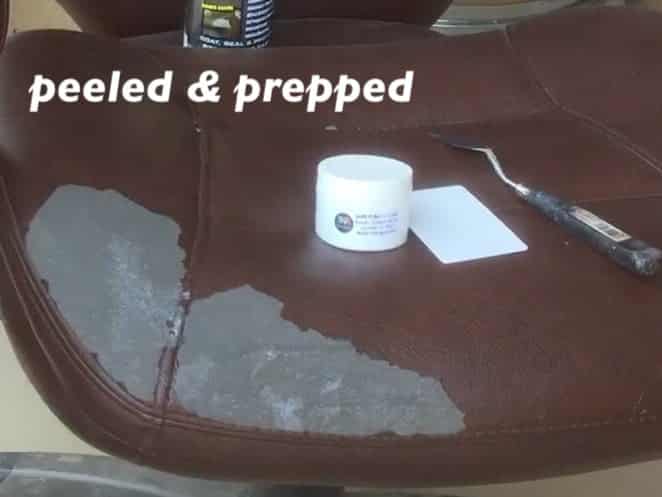
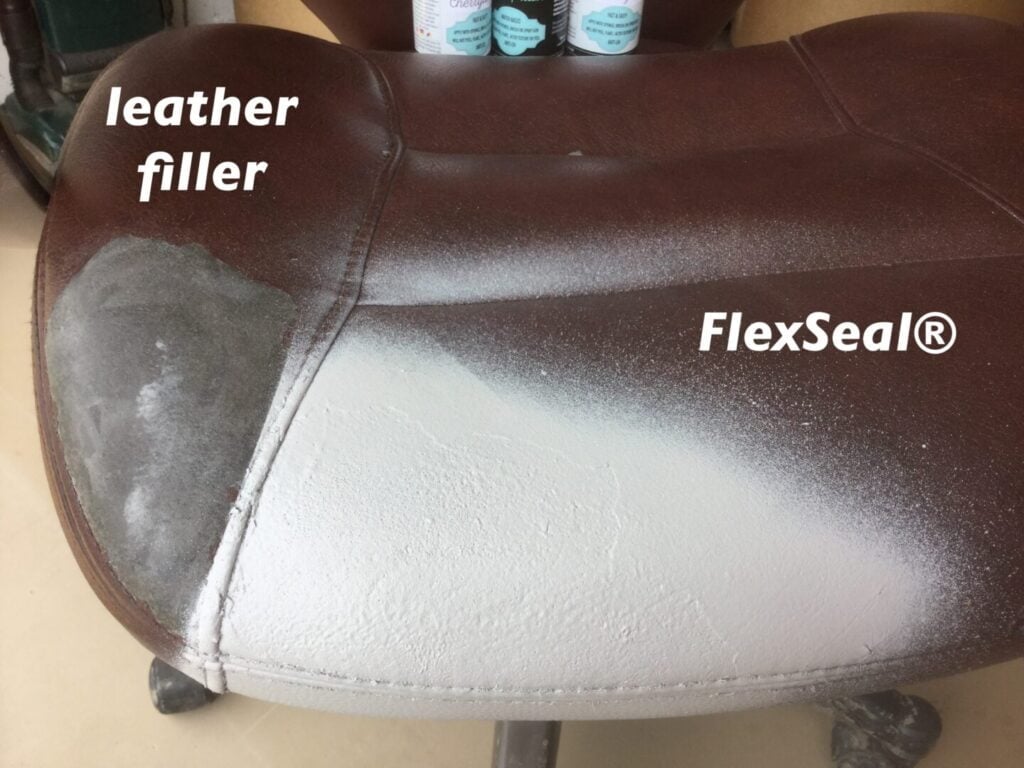
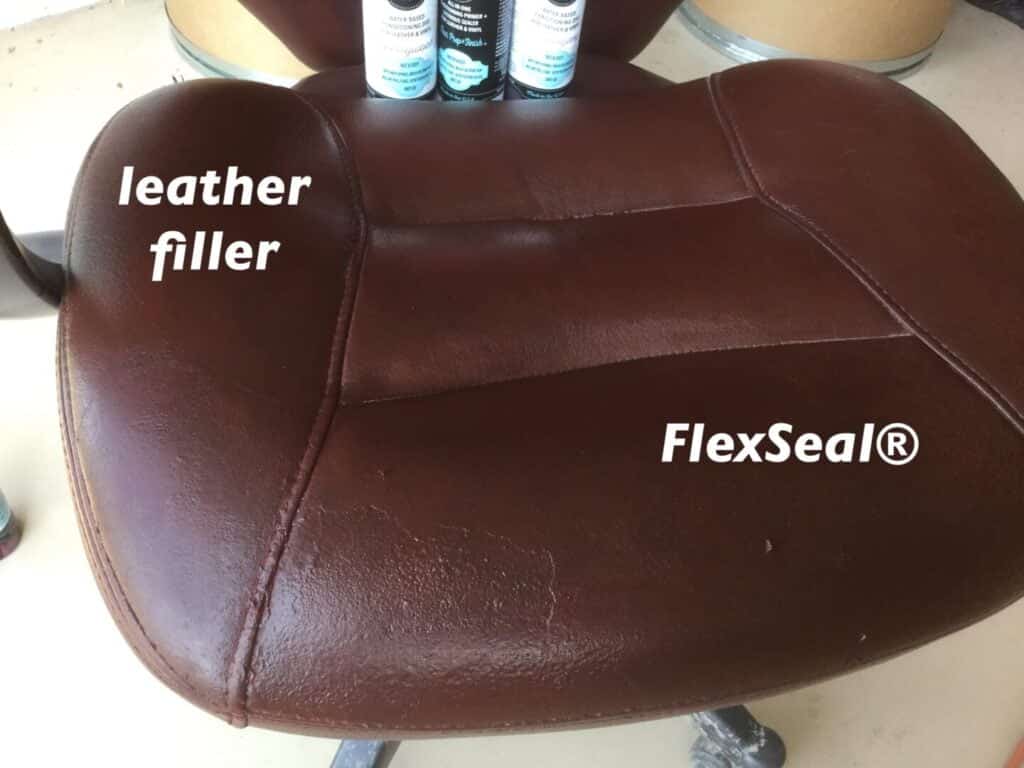
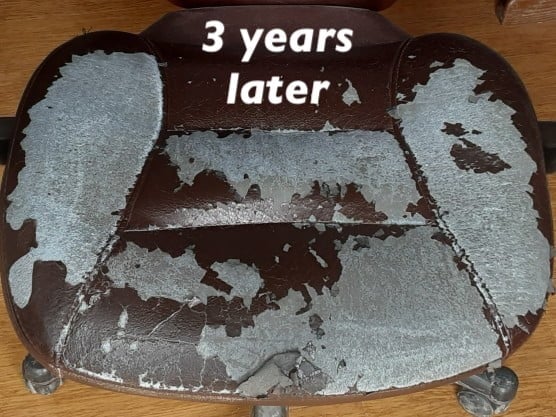
- 0:00 – Intro
- 0:28 – Prep peeling
- 0:57 – Applying Soft Filler leather repair putty
- 3:47 – Alas, more peeling
- 3:58 – Applying FlexSeal® rubber paint
- 5:13 – Comparing Soft Filler to FlexSeal®
- 5:45 – Recoloring
- 6:22 – The final result
- 6:40 – The verdict after a month of use
- 7:19 – Our recommendation
Option 3: Cut the Loss & Invest in Something Better
Replace the piece with real, good-quality leather. The restore it or even change the color. It’s amazing how many fine quality pieces can be found on Facebook Marketplace and Craigslist for just a couple hundreds dollars, if not for free. Don’t be afraid of stains, fading or even a hole. These are easily repaired with the same — if not less — effort than that of option 2. The cost may be as little as $23. Even if you need lots of repair materials and spring for color matching on a huge sectional, you won’t spend more than $250 – $300. Such an investment is worthy of a piece that cost several thousand dollars new and will last decades.



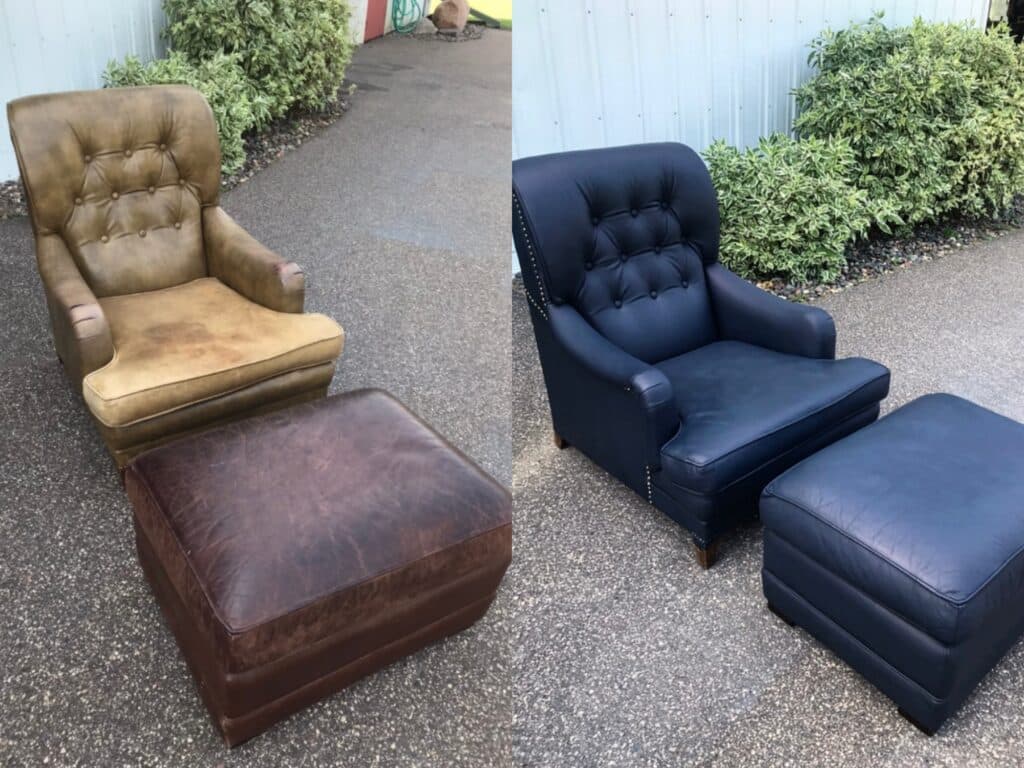
How To Spot The Finest Quality Leather
We love aniline and semi-aniline leather, which are among the best quality. These top grain or full grain leathers are dyed but have little or no clear finish, which makes them absorbent. This makes them susceptible to stains and sun fading, but it also means they can be found for cheap, often free.
Their absorbency also makes them the best candidate for a change of color, so even if you find one in the wrong shade, you can transform it to suit your décor.
Look for these features:
- Removable cushions – These require more yardage and labor. If the cushions unzip, the interior stuffing can be cleaned, plumped up or replaced. Note that most recliner chairs and sofas do not have removable cushions, but many are still a decent quality finished (non-absorbent) leather.
- Stains – Absorbent leathers with little or no clear finish will easily stain. Water marks, body oil, and pet stains may permanently stain leather, but they can usually be cleaned and concealed with a new color.
- Sun fading – Absorbent leathers often show severe and uneven fading. The dyes used in these leathers are not as UV resistant as synthetic materials, and it will be obvious.
- Marbling – Look for variation in color along with absorbency. Many fake and real leather will have a ‘base-and-print’ or two-tone appearance, but they will also repel water.
- Suede backing – The backside of the material (or areas exposed by cracks or tears) will be real suede, not microfiber or a woven fabric.
Don’t be deterred by cat scratches or a hole! These can be repaired.
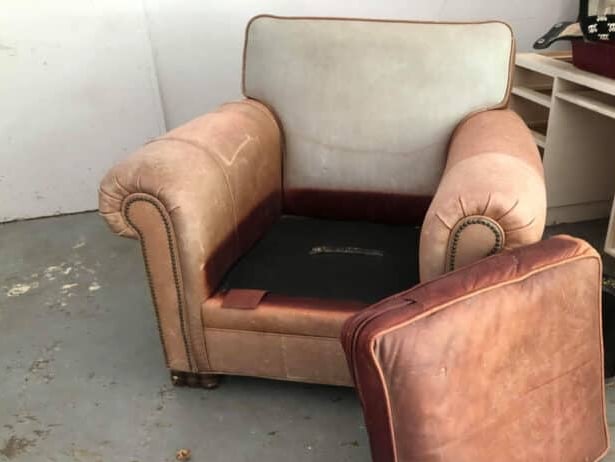
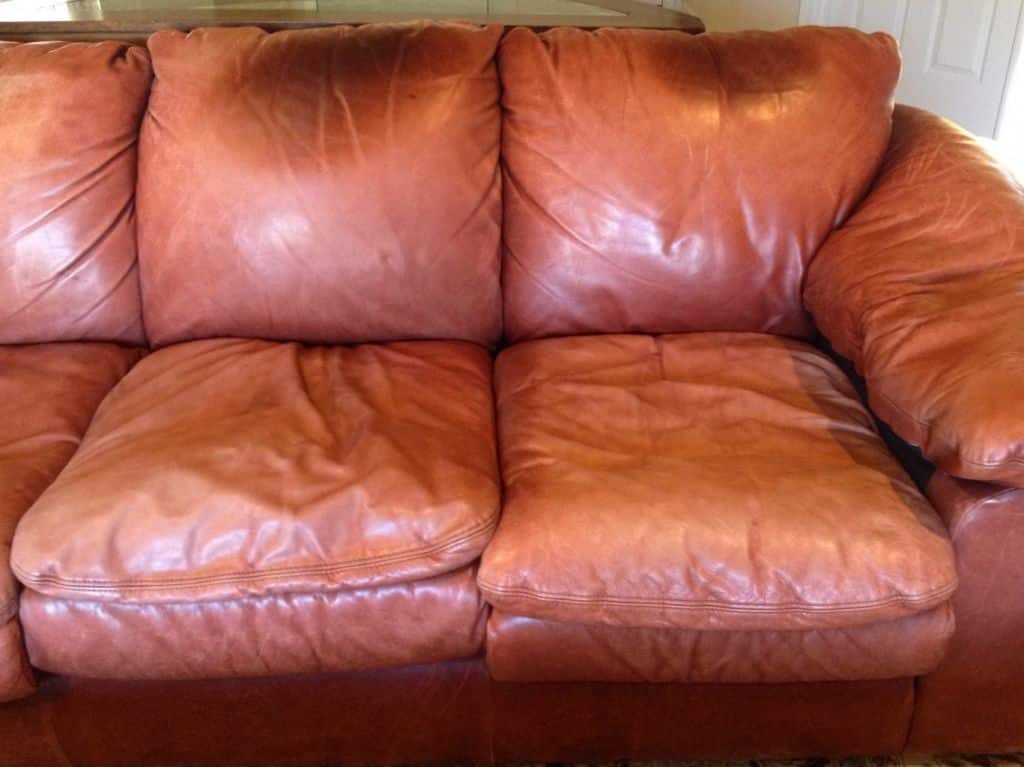
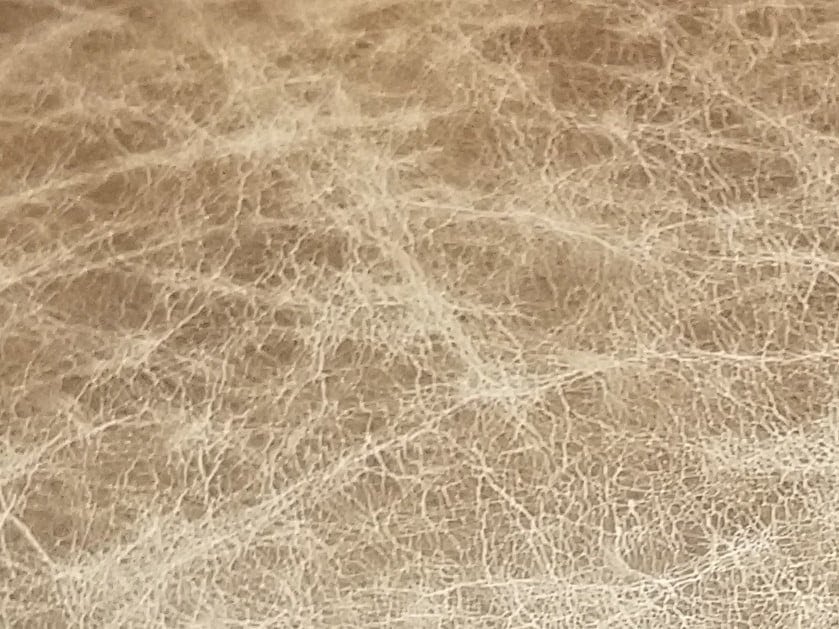
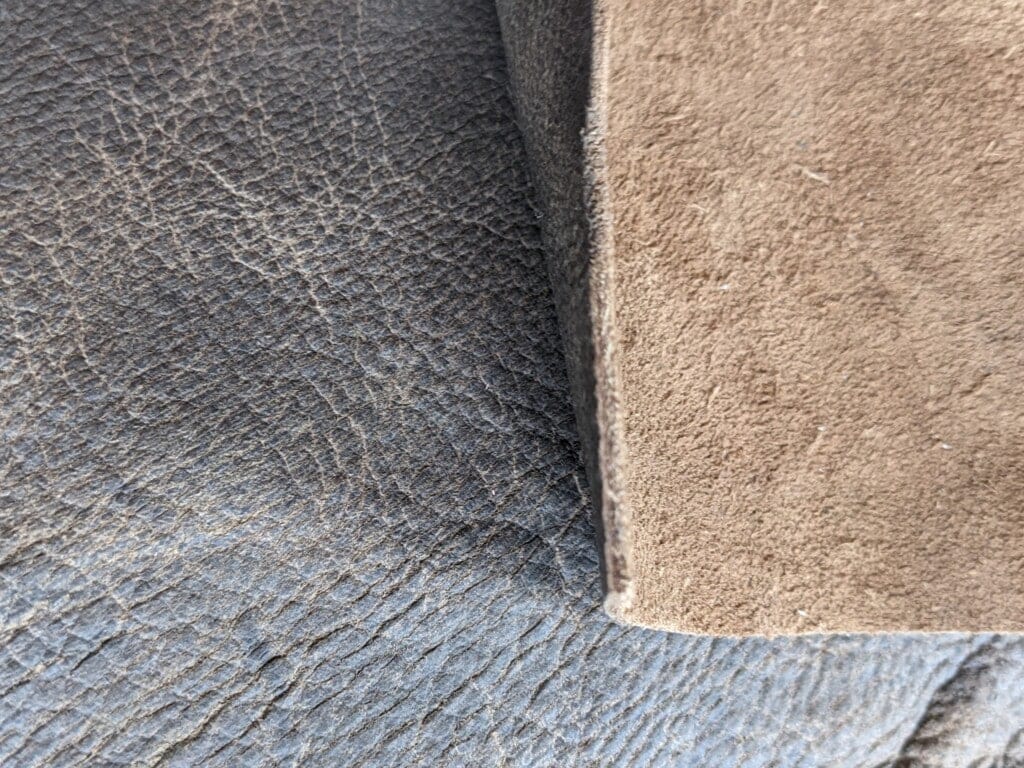
Also, don’t be fooled by some kinds of faux leather. As the smooth surface becomes worn, microfiber is exposed. It has a nap like real suede or carpet that can be brushed in any direction. These types of faux leather can be stained and coated with clear wax, but they are still poorer quality and not recommended.
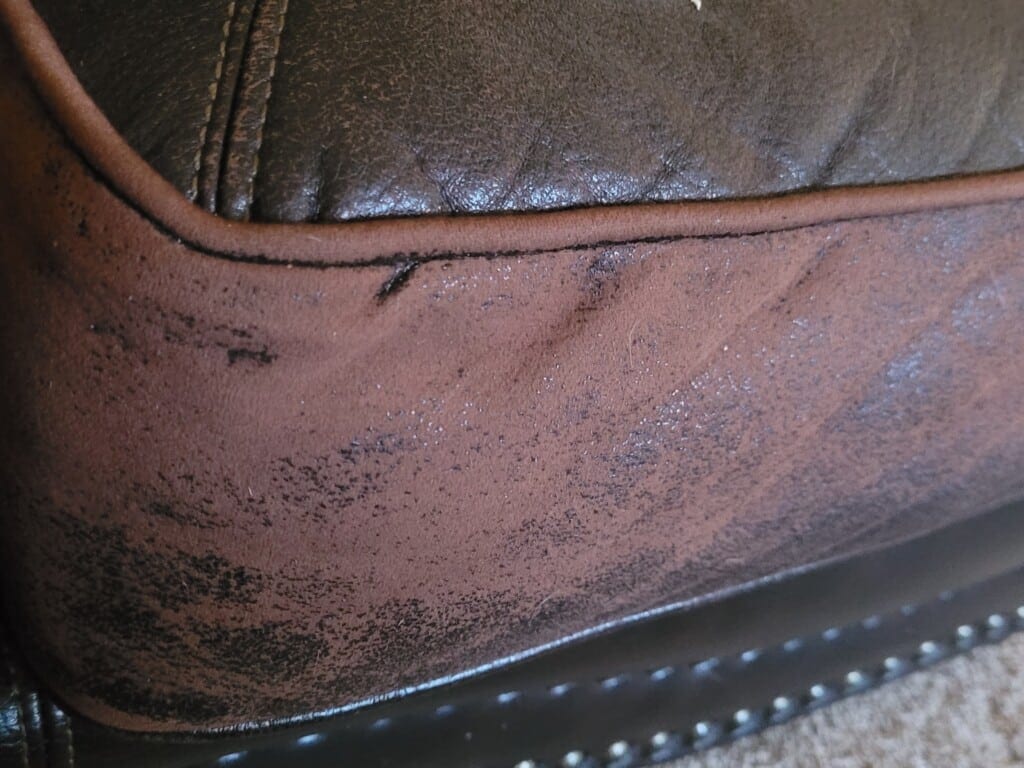

Learn more about the types of the leather as well as the differences between dyes and finishes.
If you need help, submit photos and request a consultation from the gal in the videos.
Restore 1978 silver leather interior corvette
Thank you for an interesting article on leather furniture.
We have 3 yr old faux leather dining chairs that have just started to peel. What a mess this makes, as well as being very unsightly.
We are really disappointed that this has happened to what were a nice set of chairs. A real shame that these are now destined for the rubbish dump after such a short time.
“Biting the bullet” on a more expensive replacement set is not something I was expecting so soon.
I used the Rub and Restore products on a couple of real leather couches that i got for $100 each. Knew they are probably worth about 4k each! They turned out great. I did some restuffing of the cushions in both the seats and back. A good quality couch will have removable cushions and zippers in both the seat and back cushions. Also hardwood frames, not pressed wood. Even Natuzzi uses this in some of their furniture. Research the stuffing too as some of it is really crap. Why anyone would even bother with fake leather is beyond me. I guess real leather furniture new is super expensive and hard to detect if it is actually leather or just some bonded stuff. People, do your research before you buy. I researched these couches before i bought them. Rub and Restore is a fabulous product and Lesandre is super helpful during the process if you need her. Can’t recommend them high enough. Just great.
Amazing! Thank you for restoring fine quality pieces, letting us help you, and for sharing the good word, Ginnie.
I have a set of nice kitchen table faux leather chairs, I purchased this used about 7 years ago and still look great. Only issue with them is the previous owner’s cat scratched them and there are tiny pin holes. One of my chairs now is starting to peel more where the cat had scratched, this chair is also where my 5 year old sits and is probably rougher in the chair. I’ve thought about redoing the chairs but don’t have the time right now with two little ones. I want to stop this from tearing anymore. The other chairs are still fine, I did notice a little peeling on the edge of the cushions where it squishes down but for the main seat part is still fine. I’ve seen many bonded leather chairs peeling but this hasn’t been peeling like those, I’m not sure what type of faux leather it is but any advice – if it can be repairable would be much appreciated.
Thank you
Peeling is seldom a good sign, and repairing cat scratch damage on artificial leather is painstaking. Email photos to info@rubnrestore.com or submit through our contact page.
I have a fake leather couch and it is starting to show hairline cracks like the picture you posted, is their something that I can put on it to slow the process? I am just trying to extend the life. No peeling has occurred.
We haven’t found anything that will slow the degradation. Seems everything (UV, use, other chemicals) only hasten it.
I have a solid sofa couch made with (fake) leather? that is peeling and flaking everywhere. Would it be worth me having the furniture reupholstered??
Maybe, if the frame and stuffing are good quality, and it’s a unique piece / size. But often these pieces don’t have removable cushions, and they’re difficult to dismantle and reupholster. You’ll just have to inquire with a local upholsterer.
Thanks for your reply. I will look into it further, before throwing it out. Currently we use it covered in a large rug.
my friend had the same problem with a faux leather couch flaking everywhere driving her nuts but with 3 small kids she wanted to wait to buy new furniture until her kids were older and a bit less destructive. it was still solid and sat really well so we found a stretchy/fitted durable sofa cover on amazon and secured the bottom hem all the way around the underside of the frame with a staple gun (making sure the staples were very close together so the tiny flakes were sealed underneath and none could escape) and sure enough, it worked perfectly! took maybe an hour with two of us and looked like a brand new couch! that was 2 years ago and not a single flake has escaped since then and the cover is still holding strong! hope this helps 🙂